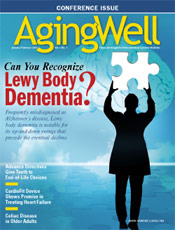
January/February 2013
Increasing Prevalence of Eating Disorders in Men?By Mike Bassett Both anecdotal and evidentiary data indicate that the prevalence of eating disorders among older men may be increasing. For example, Tamara Pryor, clinical director of the Eating Disorder Center in Denver, said in a 2012 Denver Post article that the number of male patients seeking help for eating disorders has increased steadily since 2005. While it’s unclear whether the number of aging men suffering from eating disorders is increasing, Cynthia Bulik, PhD, director of the University of North Carolina Eating Disorders Program, confirms that men are as likely as women to suffer from certain conditions such as binge-eating disorder. “And now that it’s poised to be recognized as an official eating disorder in the new Diagnostic and Statistical Manual, we expect that we will see even more men presenting for treatment,” she says. Since women stereotypically suffer from eating disorders, obtaining treatment for men can be difficult, according to Bulik. “Since [eating disorders] are not even on the radar screens of physicians and other healthcare providers when men come into the clinic, they simply don’t ask the questions,” she says. “Many men we have spoken to have said that they have actually gone to the doctor and laid out their symptoms, and physicians have still not wanted to believe it was an eating disorder. Instead they would order lots of tests to rule everything under the sun out first because of the stereotype that men don’t get eating disorders. This is patently false.” Research performed in the 1990s by Paul Hewitt, PhD, and Stanley Coren, PhD, of the University of British Columbia demonstrated that older men are more susceptible to eating disorders than widely assumed. In the course of researching the incidence of anorexia among people of all ages, they determined that among people who died from anorexia, just 10% were male. But among those over the age of 45, 21% were men. It’s possible that many men have gone undiagnosed, with symptoms simmering but not boiling over until a traumatic event sets them off. Edward Tyson, MD, a physician in Austin, Texas, specializing in the evaluation and treatment of eating disorders, says he recently treated a 65-year-old man whose eating disorder probably could be traced back to his college days. “The older a patient gets, it’s possible we may never even see him because [the eating disorder] has never been diagnosed,” Tyson says. “This patient was seen by many doctors but was never diagnosed. Finally, he fell severely ill, and a dietitian recommended that he come and see me.” Contributing Factors And once the disorder has victimized an aging man, it’s not particularly easy to diagnose it, Tyson says. “They will not accept the diagnosis or even get their condition assessed. Once a man gets to a certain age, it’s a lot harder for them to seek treatment,” he explains. In the case of anorexia nervosa, physicians should look for weight loss or the compulsion to exercise. “Many of these men are restrictors,” Tyson says. “They’re limiting their calorie intake, and they can be heavy into exercise so that they appear to be living a healthy lifestyle. Doctors need to check vitals signs. Is he getting enough calories? Is his body temperature warm enough? Is his blood pressure dropping excessively?” Patients with the disorder will have a rigid approach to eating and exercise, Tyson says, and as diets become more restrictive, there will be more rituals around food and exercise. This kind of behavior could have visible psychological implications, he adds, with individuals becoming short-tempered and flatter in mood and affect. With bulimia nervosa, Bulik says physicians should question patients about whether they feel as though their eating behavior or appetite is out of control. She adds that physicians shouldn’t tell men to lose weight without inquiring about the possibility of binge eating. If a patient does engage in binge eating, physicians should ask about purging behaviors, such as whether a patient self-induces vomiting or engages in intense exercise after binging. Binge-eating disorder is binge eating without those compensatory behaviors and can manifest itself in individuals who are overweight and normal weight. Embracing a Diagnosis Tyson says he also recommends that a patient diagnosed with an eating disorder meet with a dietitian who has experience with eating disorders as well as a therapist since the patient “is not going to get through this accidentally.” According to Bulik, an anorexia nervosa diagnosis may require hospitalization for a renourishment phase, while bulimia and binge-eating disorder are typically treated on an outpatient basis and often involve cognitive behavior therapy. “But to be completely frank, the treatments that we have been developing are primarily for women,” she says. “We do not have clear clinical trials that tailor treatment for men.” There are treatment centers that specialize in helping men, she adds, suggesting that some men could find it helpful to be around other men with similar problems. “But we need more research to figure out how best to provide differentiated care for men who suffer from eating disorders.” — Mike Bassett is a freelance writer based in Holliston, Massachusetts. |
![]()
